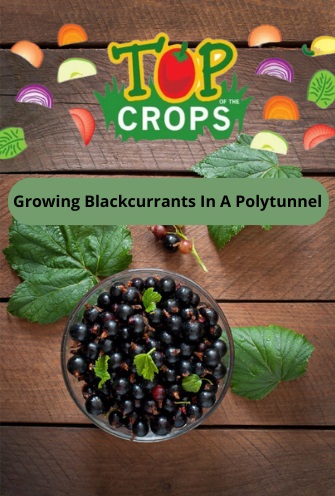Welcome to Top of the Crops - today, you will learn how to grow blank in a polytunnel. For more gardening insights, be sure to check out our blog Polytunnel Gardening too!
Blackcurrants are a healthy fruit and can be used in a wide range of recipes while fresh, or preserved in jams etc. or frozen for later use. Growing them in a polytunnel or fruit cage, or elsewhere in your garden, can be a wonderful idea.
Blackcurrants can be grown in either containers or in the soil in your polytunnel. While they can survive and thrive outside in much of the UK, growing currants such as these in a polytunnel can help to protect them from the vicissitudes of the UK weather.
Blackcurrants are delicious in a range of puddings and preserves and can be eaten or drunk in a number of different ways – the good news is, they are also easy to grow.
| Jan | Feb | Mar | Apr | May | Jun | Jul | Aug | Sep | Oct | Nov | Dec | |
| Plant |  |
 |
 |
 |
 |
|||||||
| Harvest |  |
 |
 |
When choosing a location for your blackcurrant bush, be sure to choose a location, whether that is within your polytunnel or not, where it will be in full sun, as bushes will not fruit as well in the shade. However, these are shrubs that can tolerate a little light or dappled shade.
Whether in the beds in your polytunnel or in containers, blackcurrants should be in a well-drained but moisture retentive soil/ growing medium.
Blackcurrants are usually purchased either as a bare root or container plant. Bare root blackcurrants are the more affordable option and are available during the dormant season.
More modern varieties tend to have fruits that ripen all at once while older cultivars have fruits that ripen at different times, which makes harvesting a little more time consuming.
Contemporary cultivars also tend to flower later so are better for colder and more northern locations, since if the plants experience frost while in bloom, fruiting will not be as good. And the fruits are also often larger on modern blackcurrant varieties.
Most blackcurrants will grow to around 1.5m in height, with around 5-10 stems growing from the base of the shrub. However, there are some more compact varietals that are ideal for smaller spaces or if you wish to grow your blackcurrants in a container.
And some blackcurrants are trained to grow as standards, with one single stem with a tree-like canopy on top.
The names of some highly regarded varieties are given towards the end of this guide.
First of all, if you do not already have one in place, erecting a fruit cage or polytunnel is a good idea. Make sure that you place an area for soft fruits like blackcurrants in a suitable spot, with enough sun and moist but free-draining soil.
Before planting your blackcurrants, think about how they will fit into the garden planting scheme overall and which neighbours they will have. Selecting the right companions can be important, along with providing the right environmental conditions.
Clear the planting area of weeds and make sure it is rich in organic matter before planting. Top dress the planting area with plenty of garden compost or well-rotted manure, especially if you have a light soil where you live and need to improve moisture retention.
You can plant blackcurrants more or less the same way as you would other shrubs in your garden. But interestingly, unlike with many other plants, you should not plant them at the same depth but slightly deeper.
When planting your blackcurrants, whether pot grown or bare root, to their final growing positions, you should dig your hole and spread out the roots.
Unlike for many other plants, blackcurrants should be placed deeper in the ground than they were in their previous pot/ location.
The recommendation is generally to plant them 5-6cm deeper than they were before. Firm the soil well around the plant and water in well, adding a thick mulch of good quality compost in the spring.
If you plan on growing blackcurrants in containers then it is best to choose one at least 45cm in diameter. Again, try to place the plant slightly deeper than it was in its previous pot. Fill the container with A peat-free, multipurpose potting mix with grit or sharp sand added to improve drainage.
It is important to note that blackcurrants do not tend to do well in containers long-term. But more compact varieties such as 'Ben Gairn' and 'Ben Sarek' can be fine for a few years, but may begin to fruit poorly longer term.
You will still need to repot every couple of years, even when growing more compact varieties, trimming back the rootball where necessary.
Established blackcurrants are excellent low-maintenance shrubs that will not really take much work or need that much attention beyond an annual prune. However, there are a few care needs, especially before young plants become properly established.
It will be especially important to water blackcurrant bushes well during their first summer season. They may still occasionally need to be watered during prolonged dry spells once fully mature but when grown outdoors they should generally find natural rainfall sufficient.
Of course, you will always need to water in a polytunnel and plants in containers will need to be watered much more frequently than those growing in the ground.
Try to water at the base of the bushes rather than from above, and avoid heavy watering during the fruiting period or the currants' skins can split.
Organic, nitrogen-rich liquid feed may help blackcurrants when applied in the spring and summer – a nettle liquid feed is ideal. This can be especially beneficial when growing in containers.
In late winter or early spring, replenish the mulch around blackcurrant bushes and add an organic, high potassium general fertilizer around the base of the plant. The layer of organic mulch should be around 5cm deep, but should not touch the base of the stems or them can rot.
While blackcurrant bushes are tolerant of a lot and can cope with a range of conditions, there are times when protection will likely be required.
The flowers are vulnerable to frosts and if exposed to frost, may drop off or be damaged and lead to a diminished harvest of fruits or even none at all.
If a frost is forecast, therefore, while the blackcurrant bush is in bloom, cover the bushes at night with fleece or hessian but make sure that you remove this in daylight hours to make sure that pollinators can access the flowers.
Once the fruits ripen, these are vulnerable to being eaten by a range of garden wildlife – especially birds. This is why it is beneficial to grow these bushes undercover, so that birds do not eat all the yield before you get the chance to harvest.
If you are not growing undercover, it is usually essential to net your plants as soon as the currants start to ripen or you can lose the lot. Make sure that any netting is pulled taut and secured well so that birds cannot get tangled in it.
Blackcurrants are very easy to propagate by means of hardwood cuttings, taken from young plants in mid to late autumn or winter. It is only a good idea to take cuttings from younger plants as older ones can harbour viruses that will lead to the propagation of weaker plants.
The main job when growing blackcurrants is pruning, and this is where many gardeners may go wrong. Learning how to correctly prune currant bushes is important in order to get the best results.
We prune blackcurrants in order to maintain a bush with a good open-centred form with 5-10 upright stems for fruit production. By removing older, less productive stems, we can ensure that we maintain a good form and that fruit production does not diminish over time and encourage strong new growth.
Prune established blackcurrant bushes annually in winter, aiming to remove up to a third of the older stems each year, down to the ground level.
The oldest stems are a darker brown colour and are usually thicker. Use some clean, sharp loppers/ a pruning saw to cut these off neatly without wounding the plant or introducing an avenue for infection.
Bare root blackcurrants are best cut back sharply after planting as this will encourage strong new shoots to pop up from beneath the soil. By summer, new shoots will have appeared and you may have fruit as little as one year from planting.
After the initial more drastic prune, blackcurrants are then best only pruned lightly for the next few years. In the autumn or winter, just remove low or weak shoots on healthy plants. However, if growth is not good, a hard prune – cutting at least half the shoots down to the base, can stimulate new growth to grow more strongly.
Even one blackcurrant bush can give a good yield. One mature bush can provide up to around 4.5kg of currants once mature.
Blackcurrants will ripen some time between June and August. Newer varieties will ripen one strig, or bunch of fruit, at a time, while older varieties will require harvesting over a longer period as the berries will ripen at different times and will have to be picked individually.
Take care not to squash the currants when harvesting, and note that the juice stains easily.
Of course, blackcurrants can often be used within a few days of harvesting. You can also however preserve your crop by freezing them, or making them into preserves. Jams, jellies and cordials and the like can all be water bath canned so that you can safely store them and enjoy them at a later date over the next year or two.
I typically make several jars of blackcurrant jam and several jars of blackcurrant cordial from those I grow in my garden each year. But there are of course plenty of other excellent blackcurrant recipes to choose from.
Some highly regarded blackcurrant varieties are:
'Ben Connan' (AGM)
'Ben Gairn'
'Ben Hope'
'Ben Sarek'
'Big Ben' (AGM)
Blackcurrants are generally fairly robust but can suffer from various viruses and fungal diseases such as mildew and currant and gooseberry leaf spot that can affect vigour and yield.
A number of pest species can also occasionally become an issue, such as blackcurrant big bud mite, blackcurrant gaul midge, and currant aphids, to give a few examples. But birds eating all the currants is often the biggest issue where the plants are not adequately protected.
If you decide to grow blackcurrants in a polytunnel, getting it right when it comes to ventilation throughout the year is important to prevent fungal issues. Not watering or irrigating from above is also important.
Companion plant to draw in pollinators and for pest control, with aromatic herbs and flowering plants to increase potential yields.
Hardwick, N., (2014) Top 10 Blackcurrant Recipes. [online] Available at: https://www.bbcgoodfood.com/howto/guide/seven-ways-cook-blackcurrants
